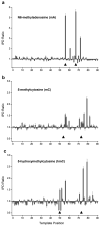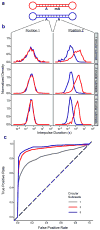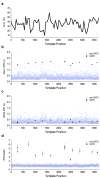Direct detection of DNA methylation during single-molecule, real-time sequencing
- PMID: 20453866
- PMCID: PMC2879396
- DOI: 10.1038/nmeth.1459
Direct detection of DNA methylation during single-molecule, real-time sequencing
Abstract
We describe the direct detection of DNA methylation, without bisulfite conversion, through single-molecule, real-time (SMRT) sequencing. In SMRT sequencing, DNA polymerases catalyze the incorporation of fluorescently labeled nucleotides into complementary nucleic acid strands. The arrival times and durations of the resulting fluorescence pulses yield information about polymerase kinetics and allow direct detection of modified nucleotides in the DNA template, including N6-methyladenine, 5-methylcytosine and 5-hydroxymethylcytosine. Measurement of polymerase kinetics is an intrinsic part of SMRT sequencing and does not adversely affect determination of primary DNA sequence. The various modifications affect polymerase kinetics differently, allowing discrimination between them. We used these kinetic signatures to identify adenine methylation in genomic samples and found that, in combination with circular consensus sequencing, they can enable single-molecule identification of epigenetic modifications with base-pair resolution. This method is amenable to long read lengths and will likely enable mapping of methylation patterns in even highly repetitive genomic regions.
Figures





Comment in
-
Zeroing in on DNA methylomes with no BS.Nat Methods. 2010 Jun;7(6):435-7. doi: 10.1038/nmeth0610-435. Nat Methods. 2010. PMID: 20508637 No abstract available.
-
Technology: DNA methylation while you sequence.Nat Rev Genet. 2010 Jul;11(7):454. doi: 10.1038/nrg2817. Nat Rev Genet. 2010. PMID: 20517344 No abstract available.
Similar articles
-
Detecting DNA modifications from SMRT sequencing data by modeling sequence context dependence of polymerase kinetic.PLoS Comput Biol. 2013;9(3):e1002935. doi: 10.1371/journal.pcbi.1002935. Epub 2013 Mar 14. PLoS Comput Biol. 2013. PMID: 23516341 Free PMC article.
-
SMAC: identifying DNA N6-methyladenine (6mA) at the single-molecule level using SMRT CCS data.Brief Bioinform. 2025 Mar 4;26(2):bbaf153. doi: 10.1093/bib/bbaf153. Brief Bioinform. 2025. PMID: 40205850 Free PMC article.
-
Quantitative and multiplexed DNA methylation analysis using long-read single-molecule real-time bisulfite sequencing (SMRT-BS).BMC Genomics. 2015 May 6;16(1):350. doi: 10.1186/s12864-015-1572-7. BMC Genomics. 2015. PMID: 25943404 Free PMC article.
-
Latest techniques to study DNA methylation.Essays Biochem. 2019 Dec 20;63(6):639-648. doi: 10.1042/EBC20190027. Essays Biochem. 2019. PMID: 31755932 Free PMC article. Review.
-
Shedding light on DNA methylation and its clinical implications: the impact of long-read-based nanopore technology.Epigenetics Chromatin. 2024 Dec 30;17(1):39. doi: 10.1186/s13072-024-00558-2. Epigenetics Chromatin. 2024. PMID: 39734197 Free PMC article. Review.
Cited by
-
The advantages of SMRT sequencing.Genome Biol. 2013 Jul 3;14(7):405. doi: 10.1186/gb-2013-14-6-405. Genome Biol. 2013. PMID: 23822731 Free PMC article.
-
Accurate prediction of DNA N4-methylcytosine sites via boost-learning various types of sequence features.BMC Genomics. 2020 Sep 11;21(1):627. doi: 10.1186/s12864-020-07033-8. BMC Genomics. 2020. PMID: 32917152 Free PMC article.
-
Entering the era of bacterial epigenomics with single molecule real time DNA sequencing.Curr Opin Microbiol. 2013 Apr;16(2):192-8. doi: 10.1016/j.mib.2013.01.011. Epub 2013 Feb 19. Curr Opin Microbiol. 2013. PMID: 23434113 Free PMC article. Review.
-
DNA Methylation in Solid Tumors: Functions and Methods of Detection.Int J Mol Sci. 2021 Apr 19;22(8):4247. doi: 10.3390/ijms22084247. Int J Mol Sci. 2021. PMID: 33921911 Free PMC article. Review.
-
Promoter Prediction in Agrobacterium tumefaciens Strain C58 by Using Artificial Intelligence Strategies.Methods Mol Biol. 2024;2844:33-44. doi: 10.1007/978-1-0716-4063-0_2. Methods Mol Biol. 2024. PMID: 39068330
References
-
- Gardiner-Garden M, Frommer M. CpG islands in vertebrate genomes. J Mol Biol. 1987;196:261–282. - PubMed
Publication types
MeSH terms
Substances
Grants and funding
LinkOut - more resources
Full Text Sources
Other Literature Sources
Molecular Biology Databases

